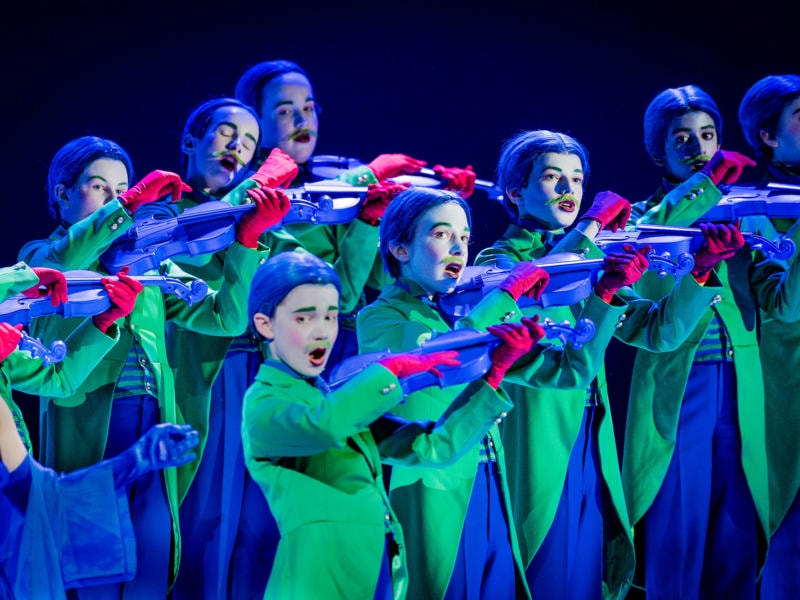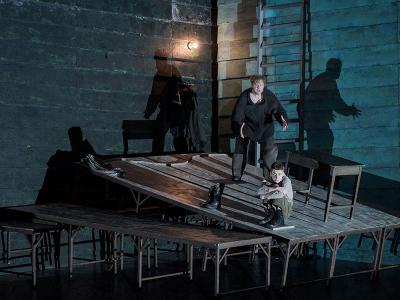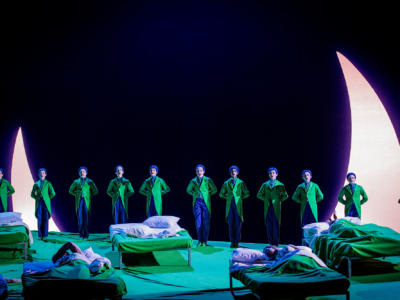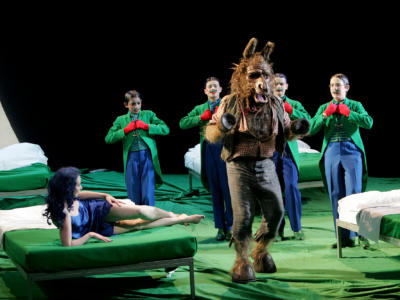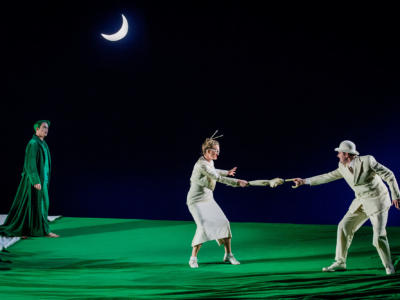Discover A Midsummer Night's Dream
Britten’s opera is based on Shakespeare’s popular comedy, which follows the consequences of a falling-out between the fairy-king Oberon and his queen, Tytania. Mistaken identities, confused lovers and alarming transformations are the result.
From the sliding string chords of the magic wood to the rustics’ well-intentioned entertainment, Britten’s ear for beguiling orchestration and melodic invention will enchant and entice you.
Synopsis
Act I
Oberon and Tytania have quarrelled over a boy whom Tytania refuses to relinquish to her husband. Oberon decides to punish her and sends Puck in search of a magic flower. Four young people appear: Hermia and Lysander wish to marry, but have run away to escape her father’s order that she must marry Demetrius. The latter is being pursued by Helena, whom he does not love. Oberon decides that, with the aid of the magic flower, he will be able to make Demetrius reciprocate Helena’s love. Six rustics, led by Quince and Bottom, meet to prepare a play which they hope to perform in front of Theseus and Hippolyta, to celebrate their wedding. Oberon squeezes the juice of the magic flower into the sleeping Tytania’s eyes: when she awakes she will fall in love with the first creature that she sees.
Act II
Bottom and his companions rehearse their play. Puck transforms Bottom into an ass. Tytania awakes, sees Bottom, and is enraptured. She summons four of her attendants to wait on her new lover, and then she and Bottom fall asleep. Oberon observes this with satisfaction, but is angry when he discovers that Puck has confused Demetrius with Lysander. Oberon’s attempt to correct this mistake makes things even worse: the two men who were in love with Hermia now both love Helena. When the four lovers quarrel violently, Oberon orders Puck to separate them and restore order.
Act III
Oberon, now in possession of the disputed boy, is prepared to make peace with Tytania. He frees her from her infatuation and husband and wife are reconciled. The four young people wake up: love is renewed between Hermia and Lysander, and new-born between Helena and Demetrius. They decide to ask Theseus’s permission to marry. The rustics lament the loss of their friend Bottom, and the inevitable cancellation of their play. Bottom, now restored to normal, joins his friends and they leave joyfully.
Theseus pardons the young lovers, and gives them permission to marry. He then invites the rustics to perform their entertainment at his and Hippolyta’s wedding reception. When midnight strikes, Theseus declares that it is time for bed. Oberon, Tytania, the fairies and Puck appear and give their blessing.
Frequently asked questions about A Midsummer Night’s Dream
When was A Midsummer Night’s Dream written?
Whilst some uncertainty exists around the exact date A Midsummer Night’s Dream was written, scholars and historians believe Shakespeare likely wrote it between the years of 1594 and 1596.
What is A Midsummer Night’s Dream about?
A Midsummer Night’s Dream is a comedy play that involves the intertwining stories of several different groups of characters. The main storyline surrounds the upcoming wedding between Duke Theseus of Athens and the Amazonian queen, Hippolyta. Meanwhile, Hermia, Lysander, Helena and Demetrius are four young lovers who find themselves in a complicated love quadrangle. The opera embraces whimsical and fantastical elements alongside a strong portrayal of the complexities of human relationships.
Is a Midsummer Night’s Dream a comedy or a tragedy?
The play sits within the comedy category as one of Shakespeare’s most loved of the genre, filled with humorous scenes, mistaken identities and plenty of light-hearted situations, this mischievous play focuses (as many of Shakespeare’s comedies did) on the humour found in troublesome and awkward situations.
Why did Shakespeare write A Midsummer Night’s Dream?
Whilst many scholars have suggested the play was written for a performance at a wealthy aristocrats wedding, there is no conclusive evidence as to the reason why Shakespeare wrote A Midsummer Night’s Dream. With comedy a very popular genre at the time, Shakespeare may have just wanted to produce entertainment that catered to the current audience interest.
Where is A Midsummer Night’s Dream set?
The comedic play is set in Athens and a nearby enchanted forest.
How long is A Midsummer Night’s Dream?
A performance of A Midsummer Night’s Dream is approximately 2hrs 20mins, including one interval.
When is A Midsummer Night’s Dream set?
Shakespeare wrote A Midsummer Night’s Dream to be set in ancient Athens, however his depiction is not historically accurate and serves instead as a fictional backdrop where the boundaries between reality and imagination are blurred.
What are the themes in A Midsummer’s Night’s Dream?
A Midsummer Night’s Dream explores the themes of love, fantasy and the unpredictable nature of human emotions.

